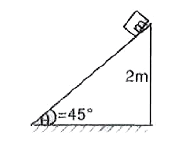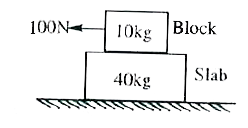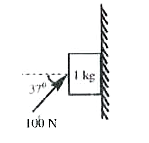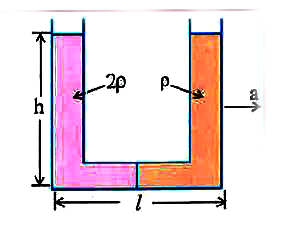The co-efficient of friction between an insect and bowl is ul and the radius of the bowl is r. The maximum height to which the insect can crawl in the bowl isSolution in Telugu
The correct Answer is:A
Step by step video, text & image solution for The co-efficient of friction between an insect and bowl is ul and the radius of the bowl is r. The maximum height to which the insect can crawl in the bowl is by Physics experts to help you in doubts & scoring excellent marks in Class 11 exams.
Topper's Solved these Questions
- BOOK - AAKASH SERIESCHAPTER - FRICTION EXERCISE - LECTURE SHEET EXERCISE- III (INTEGER TYPE QUESTIONS)2videos
FRICTION
- BOOK - AAKASH SERIESCHAPTER - FRICTION EXERCISE - LECTURE SHEET EXERCISE- IV (STRAIGHT OBJECTIVE TYPE QUESTIONS)6videos
FRICTION
- BOOK - AAKASH SERIESCHAPTER - FRICTION EXERCISE - LECTURE SHEET EXERCISE- II (INTEGER TYPE QUESTIONS)1videos
FRICTION
- BOOK - AAKASH SERIESCHAPTER - FLUID MECHANICSEXERCISE - Questions for Descriptive Answers14videos
FLUID MECHANICS
- BOOK - AAKASH SERIESCHAPTER - GAUSS.S LAW EXERCISE - PROBLEMS (LEVEL - II)12videos
GAUSS.S LAW
Similar Questions
A wedge of mass 2m and a cube of mass m are shown in figure. Between cube and wedge, there is no friction. The minimum coefficient of friction between wedge and ground so that wedge does not move is 2×10−x where x is
 05:59View Solution
05:59View SolutionA 40kg slab rests on a frictionless floor. A 10kg block rests on top of the slab. the static coefficient of friction between the block and the slab is 0.60 and The coefficient kinetic friction between the block and the slab is 0.40. A horizontal force of 100N is applied on the 10kg block. Find the resulting acceleration of the slab. (g=10ms−1)
 05:13View Solution
05:13View SolutionA body is pushed against vertical wall as shown. If the coefficient of friction between the body and the wall is 0.5, the magnitude of acceleration of the block is 10 K. Where K is
 05:13View Solution
05:13View SolutionA U-tube of base length I filled with same volume of two liquids of densities ρ and 2ρ is moving with an acceleration a on the horizontal plane. If the height difference between the two surfaces (open to atmosphere)becomes zero,then find height h
 05:13View Solution
05:13View SolutionA charge q is placed at the centre of the open end of a cyclindrical vessel. Find the flux of the electric through the surface of the vessel.
02:34View SolutionCalculate the height upto which an insect can crawl up a fixed bowl in the from of a hemisphere of radius r Given coefficient of friction = 1 sqrt(3) .
03:30View SolutionA hemispherical bowl of uniform mass distribution of mass ‘M’ is at rest on frictionless horizontal ground sur- face. There is a small insect of mass 'm' on bowl at point ‘A’ of the bowl at rest. Now the insect moves with constant speed ‘v’ relative to bowl in vertical plane. Assume that insect does not slip on the bowl. When the insect reaches point ‘P’ of the hemisphere the displacement of hemisphere w.r.t. ground is :
06:01View SolutionA hemispherical bowl of uniform mass distribution of mass ‘M’ is at rest on frictionless horizontal ground sur- face. There is a small insect of mass 'm' on bowl at point ‘A’ of the bowl at rest. Now the insect moves with constant speed ‘v’ relative to bowl in vertical plane. Assume that insect does not slip on the bowl.

When the insect is at point ‘P’ of the hemispherical bowl the acceleration of bowl is :03:35View SolutionA hemispherical bowl of uniform mass distribution of mass ‘M’ is at rest on frictionless horizontal ground sur- face. There is a small insect of mass 'm' on bowl at point ‘A’ of the bowl at rest. Now the insect moves with constant speed ‘v’ relative to bowl in vertical plane. Assume that insect does not slip on the bowl.

When insect at point ‘P’ on the bowl the displacement of centre of mass of the system (bowl + insect) is :View SolutionThe coefficient of friction between a hemispherical bowl and an insect is sqrt(0.44) and the radius of the bowl is 0.6m . The maximum height to which an insect can crawl in the bowl will be .
View SolutionIf the coefficient of friction between an insect and bowl is μ and the radius of the bowl is r, find the maximum height to which the insect can crawl in the bowl.
04:40View SolutionA small insect is climbing slowly along the inner wall of a hemispherical bowl of radius R. The insect is unable to climb beyond theta = 45^(@) . Whenever it tries to climb beyond theta = 45^(@) , it slips. (a) Find the minimum angular speed omega with which the bowl shall be rotated about its vertical radius so that the insect can climb upto theta = 60^(@) . (b) Find minimum omega for which the insect can move out of the bowl.
05:32View SolutionCalculate the height upto which an insect can crawl up a fixed bowl in the form of a hemisphere of radius r. Given coefficient of friction is 1/√3.
03:30View SolutionThe coefficient of friction between an insect and a hemispherical bowl of radius r is mu . The maximum height to which the insect can crawl in the bowl is
05:16View SolutionThe coefficient of friction between a hemispherical bowl and an insect is √0.44 and the radius of the bowl is 0.6m. The maximum height to which an insect can crawl in the bowl will be
03:31View Solution

